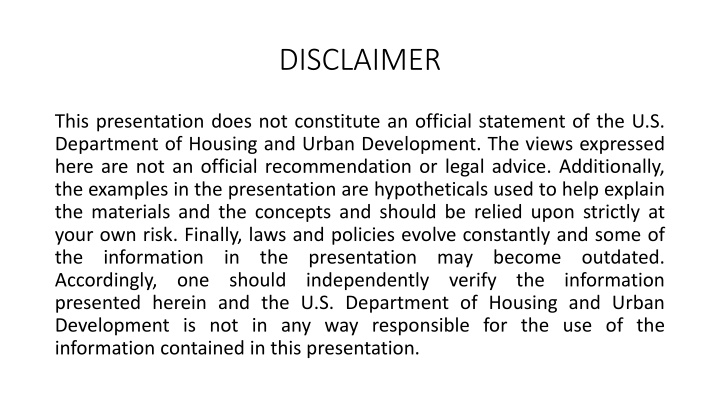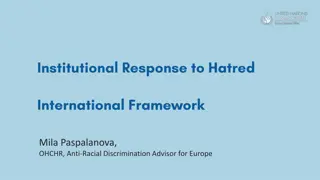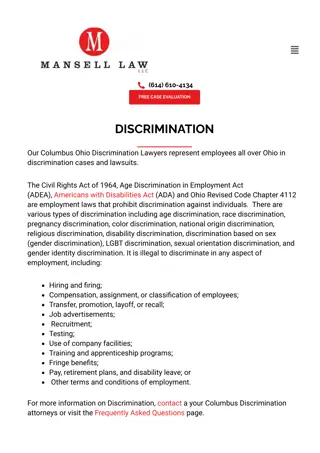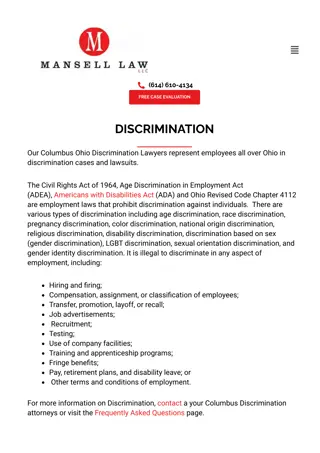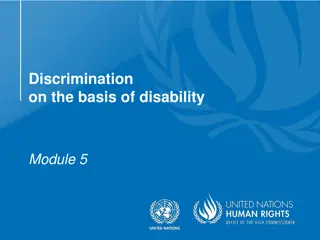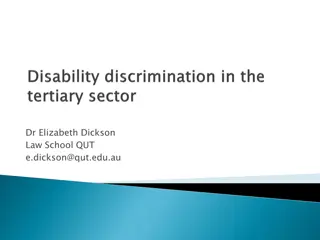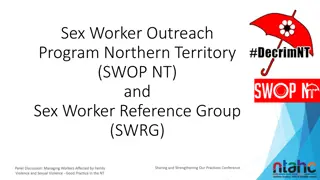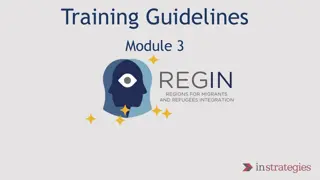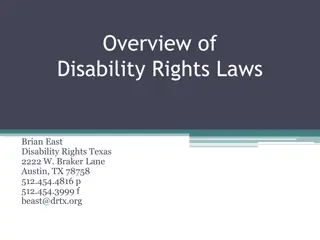Anti-discrimination Laws Associated with NAHASDA
This presentation explores the anti-discrimination laws applicable to NAHASDA recipients, covering key regulations such as Section 504 of the Rehabilitation Act of 1973. It delves into the programmatic, construction, and accessibility requirements under Section 504, providing insights into handling violations and accommodation requests. The session also outlines the enforcement processes and HUD investigation procedures related to Section 504.
Download Presentation

Please find below an Image/Link to download the presentation.
The content on the website is provided AS IS for your information and personal use only. It may not be sold, licensed, or shared on other websites without obtaining consent from the author.If you encounter any issues during the download, it is possible that the publisher has removed the file from their server.
You are allowed to download the files provided on this website for personal or commercial use, subject to the condition that they are used lawfully. All files are the property of their respective owners.
The content on the website is provided AS IS for your information and personal use only. It may not be sold, licensed, or shared on other websites without obtaining consent from the author.
E N D
Presentation Transcript
DISCLAIMER This presentation does not constitute an official statement of the U.S. Department of Housing and Urban Development. The views expressed here are not an official recommendation or legal advice. Additionally, the examples in the presentation are hypotheticals used to help explain the materials and the concepts and should be relied upon strictly at your own risk. Finally, laws and policies evolve constantly and some of the information in the presentation Accordingly, one should independently presented herein and the U.S. Department of Housing and Urban Development is not in any way responsible for the use of the information contained in this presentation. may verify become the outdated. information
Anti-discrimination Laws Associated with NAHASDA Sol Kim, Trial Attorney sol.t.kim@hud.gov Gabriel Arnson, Lead Equal Opportunity Specialist Gabriel.arnson@hud.gov May 2, 2018 Great Lakes Indian Housing Association
Presentation Overview A. Anti-discrimination Laws Applicable to NAHASDA Recipients B. Substantive Requirements of Section 504 General Overview Theories and Examples of Violations Reasonable Accommodation and Modification Requests C. Construction and Accessibility Requirements of Section 504 Structures built or Acquired before July of 1988 Structures built or Acquired after July of 1988 D. Programmatic Requirements of Section 504 Priority on Accessible Units and Effective Communication Policy Grievance Procedure and Section 504 Coordinator Public Notice E. Anti-discrimination Laws and Mixed Financing in Non-Indian Country F. HUD Investigation and Enforcement of Section 504
A. Anti-discrimination Laws Applicable to NAHASDA Recipients Federally Recognized Indian tribes receiving funding under Native American Housing and Self-Determination Act ( NAHASDA ) are subject to the following anti-discrimination laws: The Age Discrimination Act of 1975 Section 504 of the Rehabilitation Act of 1973 The Indian Civil Rights Act, if powers of self-government are exercised Title VI and Title VIII (the Fair Housing Act), if the tribe is not covered by the Indian Civil Rights Act. Actions under NAHASDA by federally recognized Indian tribes and their TDHEs are not subject to Title VI or Title VIII. [29 USC 794; 24 CFR 1000.12; PIH 2010-27 (extended via PIH 2011-39)]
Section 504 of the Rehabilitations Act of 1973 Section 504 states that no qualified individual with a disability in the United States will be excluded from the participation in, be denied the benefits of, or be subjected to discrimination under any program or activity receiving federal financial assistance by reason of her or his disability. HUD Regulations state that Section 504 applies to NAHASDA-funded activities HUD Notice currently in effect states that Section 504 applies to IHBG, ICDBG, and any other programs and activities funded by ONAP, including Youthbuild, Drug Elimination Programs and Model Activities. [29 USC 794; 24 CFR 1000.12; PIH 2010-27 (extended via PIH 2011-39)]
B. Substantive Requirements of Section 504 General Overview Prohibits any program or activity using federal funding from excluding, denying the equal benefits of, or discriminating against people based on disability. It s broader than simply prohibiting discrimination. The recipients must affirmatively seek to remove any obstacle that has the effect of excluding or denying the full benefits of the program. Covers all aspects of the program, including housing, model activities, and employment Some of the obligations under Section 504 include: Nondiscrimination Reasonable accommodations Reasonable modifications Effective communication Accessibility rule compliance Establishment of grievance procedure and coordinator
B. Substantive Requirements of Section 504 Definition of Disability A person with handicap or disability has: Physical or mental impairment that substantially limits one or more major life activities History of impairment, or Is regarded as having an impairment Impairment of major life activity includes: Caring for oneself, performing manual tasks, walking, seeing, hearing, speaking, breathing, sleeping, learning, concentrating, remembering, interacting with others, and many others. Does not include current abusers of alcohol or drugs who lack the ability to participate in the program and/or activity because of the abuse, or who present a direct threat to property or the safety of others because of the abuse. It is a functional definition. Diagnosis does not mean disability. Federal financial assistance covers any assistance provided or made available by HUD via any grant, loan, contract or any other arrangement, including real property loan or grant. [24 CFR 8.3]
B. Substantive Requirements of Section 504 Theories and Examples of Violations Disparate treatment Actions that are intended to provide unequal treatment to people with disabilities Denying or limiting participation in program on the basis of disability, either deliberately or by having barriers that make it difficult to participate (refusing to rent to someone who is receiving counseling for past alcoholism or drug use; refusing to rent to someone with mental disability) Segregating or separating participants who have disabilities (clustering of all accessible units in the same development or same floor of a building) Placing additional requirements based on disabilities (only renting ground floor units to person with disability; requiring applicants with mental disabilities to have a co-signer) Placing employment test or selection criteria that tends to screen out individuals with disabilities, unless such test or criteria are job-related (driving test for an office job) Making unnecessary and/or excessive inquiries related to a person s disability ( what s your condition? How long have you been seeing the doctor? ) Making statements, advertisements or communications or having written policies that are discriminatory ( We do not allow animals of any kind under any circumstances )
B. Substantive Requirements of Section 504 Theories and Examples of Violations (Cont.) Disparate impact An action that seems neutral but has effect of providing unequal treatment Failure to have adequate number of accessible units Lack of funding necessary to make reasonable accommodation/modifications Clustering all accessible units in a single project/neighborhood The above examples may also be discriminatory under the disparate treatment theory Failure to provide a reasonable accommodation or modification Failure to comply with specific programmatic requirements The program, as a whole, must be equally accessible and beneficial to people with disabilities as it is to people without disabilities.
B. Substantive Requirements of Section 504 Reasonable Accommodation Request Large number of disability complaints filed with HUD concern Reasonable Accommodation or Reasonable modification (over 50%) Request to make an exception to rule, policy, practice, service or procedure when such accommodations are necessary to afford a person with disability an equal opportunity to use or enjoy the dwelling or program Examples: A person with an emotional support animal requests a waiver of no-pet policy A person with depression has trouble focusing and requests the recipient to provide additional reminders or extra deadline for rent payments A person with mobility disability requests a parking spot close to building entrance A person with visual disability requests recipient to provide documents in braille A person requests a reasonable accommodation by providing a notice (unless the need for the accommodation is obvious) that an accommodation is needed due to a disability. No magic word or specific form is necessary (management cannot refuse to grant accommodation unless specific forms are submitted) The recipient does not need to make the request to a specific designated individual Reasonable accommodation requests cannot be restricted to certain hours, locations or formats
B. Substantive Requirements of Section 504 Reasonable Accommodation Request (cont.) Response to reasonable accommodation requests Right to verify the disability and the nexus between the functional limitations caused by the disability and the requested accommodation Example: A person with an emotional disability seeks a support animal that will motivate him or her or reduce social anxiety; a person with a mobility disability seeks a reserved parking spot close to the entrance; a paraplegic with a live-in aid requests a unit with an extra bedroom. Verification does not necessarily have to come from a medical professional. For example, receipt of SSDI may be adequate to prove disability Safeguard the confidentiality of any medical information and do not disclose the requester s disability or medical information Do not ignore requests or cease correspondence or negotiation; failure to engage in interactive process constitutes denial.
B. Substantive Requirements of Section 504 When may Reasonable Accommodation Requests be denied? Must be determined on a case-by-case basis Constitutes Direct Threat to health and safety Must be specific and supported by facts and data. There might be people who are adversely affected is not adequate. No per se dog breed can be banned; documented dangerous species ban may be more acceptable to ban Must not be based on stereotyping Undue Fiscal or Administrative Burden or Fundamental Program Alteration Must be actual and demonstrative, not speculative Evaluated on case-by-case basis Fundamental alteration: change in the nature of the program provided (reduction of rent; payment for live-in aid or medical expenses, etc.) Threat/undue burden/fundamental program alteration does not relieve the duty to engage in an interactive process. It is important to communicate the objections to enable requester to remedy any deficiencies and attempt to find an agreeable solution
B. Substantive Requirements of Section 504 Reasonable Modification Request Physical alteration of the structure when necessary for a person with a disability to have equal use and enjoyment Examples: Installing ramps, widening doors or lowering kitchen counters for people using wheelchairs Installing grab bars in bathrooms or accessible bathtubs Installing visual fire alarms for people with hearing disability Section 504 does not differentiate between accommodations and modifications, as do newer laws such as ADA or FHA Unlike in FHA, the cost of reasonable modification is borne by the accommodating management/owner of the property
B. Substantive Requirements of Section 504 Common Pitfalls Failure to engage in interactive process Lack of information or reasons for denials must be communicated so the deficiencies can be remedied; reasonable accommodation should be negotiated in cooperation Excessive Verification Attempts Limit documentation sought to only disability and nexus; do not ask for medical history, diagnosis, nature of the medical treatments, or general medical release Do not medically second guess the accommodation Relying on policy or rules to deny (including failure to follow RA process). The point of RA is to change rules, policies, practices or services. Refusal based on speculative or unsupported reasons (allergies, everyone will ask for the accommodation, etc.) Failure to train the staff to recognize reasonable accommodation requests Service animal (ADA) versus support animal (Section 504): no training required Resources HUD-DOJ Joint Statement on Reasonable Accommodation HUD-DOJ Joint Statement on Reasonable Modification
C. Construction and Accessibility Requirements In addition to requiring programs to be accessible as a whole, Section 504 requires specific minimum number of accessible units (not safe harbors) Structures Built or Acquired Before July of 1988 Housing Facilities If a multifamily project with 15 or more units undergoes a substantial alteration (75% of the replacement cost), then it must meet the same requirements as new multifamily structures: 5% of the units must meet the full accessibility standard, with additional 2% of the units hearing or visual impairment accessibility standards. For any other alteration or rehabilitation, units must be made accessible to the maximum extent feasible This obligation to continuously increase the stock of accessible units applies until five percent of the units in multifamily projects meet the accessibility standard (although HUD may prescribe a higher percentage depending on the need) [24 CFR 8.23]
C. Construction and Accessibility Requirements Structures Built or Acquired Before July of 1988 (Cont.) Non-housing Units In addition to operating each non-housing program or activity readily accessible to and usable by people with disabilities, any alteration to facilities must, to the maximum extent feasible, be made readily accessible to people with disabilities Key issues are often office entrances, pedestrian routes, and parking lot accessibilities Possible ways of maximizing accessibility: Reassignment of services to accessible buildings, assignment of aides, provision of housing or services at alternate accessible site, alternating of existing facilities, or any other method that makes the services readily accessible. [8 CFR 8.21]
C. Construction and Accessibility Requirements Structures built or Acquired after July of 1988 Multifamily Housing Facilities with 5 or more Units Minimum of 5% of units must meet the full accessibility standards (not fewer than one) Minimum of 2% of units must meet the accessibility standards for hearing or vision impairments (but not fewer than one) All of the common areas must be accessible HUD may require higher number of minimum units Non-housing facilities The entire facility must be readily accessible to and usable by persons with disabilities Some exception to historical properties [24 CFR 8.21, 8.22]
C. Construction and Accessibility Requirements Applicable Accessibility Standards The accessibility standard mandated by Section 504 is the Uniform Federal Accessibility Standards ( UFAS ) The 2010 Americans with Disability Act Standard for Accessibility Guidelines ( ADAAG ) may also be used. However, a consistent standard must be used; recipients cannot pick and choose between two standards in a single project. ADAAG is only applicable for common areas and certain provisions of ADAAG are not applicable 11 sections that offer less accessibility than HUD s 504 Regulation and UFAS cannot be used [24 CFR 8.32; 79 FR 29671 (May 23, 2014)]
D. Programmatic Requirements of Section 504 Priority for Accessible Units Vacancies of accessible units must be offered: First to current tenants with needs (maintain a transfer waiting list) Second to applicants with needs Finally to residents or applicants without disabilities, with the agreement to transfer when an accessible unit is needed by a tenant or an applicant with disability-related needs Effective Communication Policy Identify how applicants/participants with hearing or speech impairment will communicate Contact information for Section 504 Coordinator should be identified in all correspondence and outreach/advertising materials, including websites Affirmatively solicit the need for effective communication before public meetings and sponsored events (for example, sign language interpreters, assisted living devices, Braille or other written formats, or large font documents) [24 CFR 8.27; 24 CFR 8.6]
D. Programmatic Requirements of Section 504 Grievance Procedure and Section 504 Coordinator Recipient with at least 15 employees must designate at least one person as Section 504 coordinator and adopt a grievance procedures that incorporate due process standard and provide for the prompt and equitable resolution of complaints Section 504 Coordinator must be identified in the RA policy and Grievance Procedure Public Notice Recipient with at least 15 employees must take appropriate and continuous steps to notify participants, beneficiaries, applicants and employees that it does not discriminate on the basis of disability in admission or access to, or treatment or employment in, its federally assisted programs and activities Must identify Section 504 Coordinator May be a good idea to distribute at initial application, program entry, and at each annual recertification with acknowledging signatures Recipient must ensure that members of the potentially eligible population with disabilities will have the appropriate opportunities to become informed of the notice, including by providing sign language/oral interpreters, readers, or materials in Braille. [24 CFR 8.53; 24 CFR 8.54]
E. Anti-discrimination Laws in Non-Indian Country In general, recipients of federal grants may not discriminate based on race, color, national origin, religion, sex, familial status or disability. However, Section 201(b)(6) of NAHASDA states that Title VI and Title VIII shall not apply to actions by federally recognized tribes and the tribally designated housing entities of those tribes under this Act. The provision also applies to the Alaska Native Claims Settlement Act and to state-recognized tribes that receive NAHASDA (Notice PIH 2006-34) Accordingly, on lands with Indian sovereignty, if tribes are not subject to Title VI or Title VIII if they are engaged in activities exclusively funded with NAHASDA.
E. Anti-discrimination Laws in Non-Indian Country Scenario: Tribes building/operating housing in non-Indian land while using mixed funding sources Potential Solutions (Notice PIH 2006-34) Pro ration of units: designate a proportionate percentage of the housing units as NAHASDA-assisted units in accordance with the funding mix. Other units must comply with anti-discrimination requirements. Leveraging of funds: If all of the units are only provided to low-income Native Americans, then the mixing of funds is considered leveraged and the whole project is considered to be a NAHASDA-funded action and therefore exempt from Title VI or Title VIII.
E. Anti-discrimination Laws in Non-Indian Country Outstanding Uncertainties with Pro Rata Solution: NAHASDA only exempts tribes from federal Fair Housing Act and does not specifically exempt them from state or local anti-discrimination laws. Most states have anti- discrimination laws and state laws of general applicability usually apply to tribal activities on state land (e.g. Mescalero Apache Tribe v. Jones, 411 U.S. 145 (1973)). NAHASDA only exempts actions by tribes. It is unclear if non-tribal partners or financiers will be subject to liability under anti-discrimination laws (both federal and state) if they participate in a mixed-financing or leveraging operations. Many other sources of public funds contain explicit anti-discrimination requirements. Agencies, departments and offices responsible for managing those funds may not agree with the pro ration solution or the leveraging argument. Hence it may be recommendable to seek waivers from those agencies to ensure there will be no enforcement issues (this would be a contractual action and therefore arguably exempt from Title VI/VIII exemption language in NAHASDA).
F. HUD Investigation and Enforcement Regular ONAP compliance reviews do not usually include substantive Section 504 review because FHEO, not ONAP, oversees Section 504 HUD has right to conduct compliance reviews and access information related to Section 504 compliance and reports HUD also may investigate individual complaints If HUD finds Section 504 violation, it can issue letter of finding and/or demand voluntary remedial actions There is a right to hearing if the recipient disagrees with HUD s Section 504 findings [24 CFR 8.52; 24 CFR 8.55; 24 CFR 8.56]
HUD Investigation and Enforcement: Section 504 The housing provider: Must comply with accessibility requirements for new construction and substantial rehabilitation; May not ask for documentation when the disability is obvious; May not refuse to make reasonable accommodations in rules, policies, practices, or services; For Section 504 covered units, may not refuse requests for modifications to a dwelling, at the owner s expense.
The Elements Disabled within the meaning of the Section 504. Housing provider knew or should have known of the disability. Requested a reasonable accommodation. Accommodation was reasonable and necessary to offer disabled person equal opportunity to use and enjoy the dwelling. Accommodation denied or so delayed as to equate to denial. When policy, rule or declaration is discriminatory on its face against individuals with disabilities, then no need to engage in analysis of the elements
The Elements Continued Interactive Process - Must engage! Necessity and Burden Shifting (necessity must ameliorate in some way the effects of the disability). Reasonableness: Burden of proof that there is a nexus between the requested accommodation and the disability.
The Elements Necessity At a minimum requires showing that the desired accommodation with affirmatively enhance a disabled person s quality of life by ameliorating the effects of the disability. If the proposed accommodation provides no direct amelioration of a disability s effect, it cannot be said to be necessary.
Dos and Donts May ask individuals with disabilities that are not readily apparent or known to submit reliable documentation of a disability and their related need. Or in general, may ask for disability-related need for accommodation. Don t ask for documentation showing disability if it s obvious or known Don t ask for medical records if it s obvious or known
Assistance Animals Assistance animals are sometimes referred to as service animals, assistive animals, support animals, or therapy animals. The most recent guidance uses the term assistance animal when discussion coverage under the Act and Sec. 504 [FHEO-2013-01]
Assistance Animals (cont). Definition: It is an animal that works, provides assistance, or performs tasks for the benefit of a person with a disability, or provides emotional support that alleviates one or more identified symptoms or effects of a person s disability.
Assistance Animals (cont.) Assistance animals are NOT required to be individually trained or certified. Animals other than dogs can be used as assistance animals.
Assistance Animals (cont.) Unlike service animals, which are trained to perform tasks to assist people with disabilities, emotional support animals provide therapy through companionship and affection.
Assistance Animals (cont.) Some examples of assistance provided: Guiding individuals who are blind Alerting persons to impending seizures Alerting individuals who are hearing impaired to sounds Providing protection or rescue assistance Fetching items Emotional support for PTSD
Assistance Animals (cont.) Reasonable accommodation provisions under the Act and Sec. 504 apply when persons with disabilities use assistance animals in housing where a housing provider forbids pets or maintains some policy restricting pets Breed, size, and weight limitations MAY NOT be applied for assistance animal Pet deposits do not apply to assistance animals because assistance animals are not pets
Defenses Undue fiscal and administrative burden Fundamental Alteration of the Program Health & Safety: Direct Threat
Defenses Direct Threat A dwelling need not be made available to an individual whose tenancy would constitute a direct threat to the health or safety of other individuals or whose tenancy would result in substantial physical damage to the property of others. Can t be based on stereotypes, fears or prejudices Must relate to the particular abilities of the disabled individual
Defenses Direct Threat (cont.) Must be established by objective evidence Defense is only available where the threat cannot be ameliorated by a reasonable accommodation
Defenses Undue Fiscal and Administrative Burden Case by case analysis Cost of accommodation? Availability of alternative accommodation? Financial resources of housing provider? Most courts hold that some level of expenditure is required for reasonable accommodations.
Fundamental Alteration of the Program A fundamental alteration is something that alters the essential nature of a provider s operations Fundamental alteration may include, for example, requiring a housing provider to add supportive services such as counseling or medical services that fall outside the scope of existing services offered by provider. Examined on a case by case basis.
Examples and Cases on Animal Accommodations One of the most common and controversial aspects of disability accommodation Mostly emotional and psychological disabilities more difficult to recognize and less widely understood. Many housing owners and operators have strongly object to having animals Americans with Disabilities Act has different rules and standards than Section 504 and Fair Housing Act General Framework of Reasonable Accommodation Applies Interactive Process Documentation of Disability and Nexus Safety Analysis
Examples and Cases on Animal Accommodations Common Failing Defenses They didn t tell us about the dog before they got it. Why this fails: There is no duty to give an advance notice about an emotional support animal They didn t fill out our form. Why this fails: As long as a reasonable notice is given for a reasonable accommodation, no specific form is required Why can t she have a cat instead? Why this fails: This is not a reasonable alternate accommodation, as it seeks to completely replace the accommodated animal, especially if there is no evidence that the animal sought is unsafe. I read that breed of the dog is dangerous Why this fails: Whether an animal is unsafe must be demonstrated, and not speculated. But the animal didn t receive any training Why this fails: Unlike service animals under the Americans with Disabilities Act, emotional support animals under Section 504 do not require any specific training I don t think the documentations are enough so I will just tell her no. Interactive process requirement means the tenant must be given an opportunity to remedy any inadequate documentation
Examples and Cases on Animal Accommodations Rights of Housing Provider Right to request compliance with all reasonable animal rules: Dogs on leashes outside Cleaning up No undue disruption, such as excessive barking Right to be compensated for property damage or destruction above wear and tear: Damage may be taken out of the security deposit or payment requested if the security deposit is inadequate Insurance requirement is generally not acceptable Extra security deposit (such as pet deposit) is not acceptable
